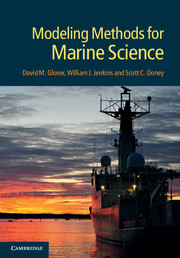Book contents
- Frontmatter
- Contents
- Preface
- 1 Resources, MATLAB primer, and introduction to linear algebra
- 2 Measurement theory, probability distributions, error propagation and analysis
- 3 Least squares and regression techniques, goodness of fit and tests, and nonlinear least squares techniques
- 4 Principal component and factor analysis
- 5 Sequence analysis I: uniform series, cross- and autocorrelation, and Fourier transforms
- 6 Sequence analysis II: optimal filtering and spectral analysis
- 7 Gridding, objective mapping, and kriging
- 8 Integration of ODEs and 0D (box) models
- 9 A model building tutorial
- 10 Model analysis and optimization
- 11 Advection–diffusion equations and turbulence
- 12 Finite difference techniques
- 13 Open ocean 1D advection–diffusion models
- 14 One-dimensional models in sedimentary systems
- 15 Upper ocean 1D seasonal models
- 16 Two-dimensional gyre models
- 17 Three-dimensional general circulation models (GCMs)
- 18 Inverse methods and assimilation techniques
- 19 Scientific visualization
- Appendix A Hints and tricks
- References
- Index
15 - Upper ocean 1D seasonal models
Published online by Cambridge University Press: 05 June 2012
- Frontmatter
- Contents
- Preface
- 1 Resources, MATLAB primer, and introduction to linear algebra
- 2 Measurement theory, probability distributions, error propagation and analysis
- 3 Least squares and regression techniques, goodness of fit and tests, and nonlinear least squares techniques
- 4 Principal component and factor analysis
- 5 Sequence analysis I: uniform series, cross- and autocorrelation, and Fourier transforms
- 6 Sequence analysis II: optimal filtering and spectral analysis
- 7 Gridding, objective mapping, and kriging
- 8 Integration of ODEs and 0D (box) models
- 9 A model building tutorial
- 10 Model analysis and optimization
- 11 Advection–diffusion equations and turbulence
- 12 Finite difference techniques
- 13 Open ocean 1D advection–diffusion models
- 14 One-dimensional models in sedimentary systems
- 15 Upper ocean 1D seasonal models
- 16 Two-dimensional gyre models
- 17 Three-dimensional general circulation models (GCMs)
- 18 Inverse methods and assimilation techniques
- 19 Scientific visualization
- Appendix A Hints and tricks
- References
- Index
Summary
Autumn to winter, winter into spring,
Spring into summer, summer into fall, –
So rolls the changing year, and so we change;
Motion so swift, we know not that we move.
Dinah Maria MulockScope, background, and purpose
So far in our models the physical characteristics of velocity and diffusivity have been specified or “hard-wired” into the calculations. The next step to consider is allowing them to respond to changing conditions. In this chapter, we will be developing and exploring a class of models aimed at simulating the seasonal behavior of the upper ocean in response to changing atmospheric forcing. We subsequently will extend this model to simulate the response of dissolved gases in the upper ocean. This approach can be more generally applied to other shallow water column properties (including bio-optical modeling, particle dynamics, etc.) with very minor modifications. What we're trying to show you here is not just how to design, build, and extend the model, but more importantly how to figure out what the model is actually doing, and how to compare its performance quantitatively with actual observations.
Generalizations
There are two general types of upper ocean models (although there are hybrids of these two as well). There are the bulk mixed layer models which, as the name suggests, treat the mixed layer as a homogeneous, well-mixed box, within which properties including chemical species, temperature, salinity, and physical momentum are uniformly distributed.
- Type
- Chapter
- Information
- Modeling Methods for Marine Science , pp. 365 - 408Publisher: Cambridge University PressPrint publication year: 2011
- 2
- Cited by



